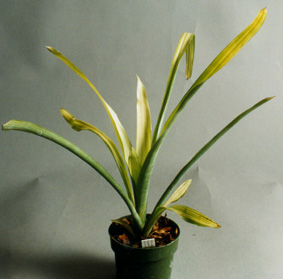A
catalogue of Bromeliads used for various projects by - © Lloyd Godman
This
is a catalogue of bromeliads used by Lloyd godman for his various installations
and photosynthesis projects - the collection of pants he accessed in
New Zealand from 1996 - 2004 was collected from a wide range of sources,
while most were brought from Greens Bromeliads, some were also donated
by the Dunedin Botanical Gardens. Later in 2004 these plants were either
sold or given away with his move to Australia.
Lloyd is at present re-establishing his collection where he now lives
in Melbourne.
A
Lexicon of Bromeliads: A
resource by Lloyd Godman
Genus - Aechmea: Sub- family - Bromelioideae: Family - Bromeliad
Generally,
Aechmeas form large urn shapes or tubular structures that hold reservoirs
of water, many are epiphytes that can adapt to growing in the ground, but they need a free draining soil. The leaves are often heavily marked with silver trichinas
and they produce colorful blooms that are long lasting. They are
found across a huge range of habitats in central and south America. Many are hardy plants and many can withstand cooler temperatures and dryer
conditions. Some have spectacular flowers which can last for months. If the flowers are pollinated the plant often forms colourful berries which contain an sticky jelly that is edible.
Plants are marked NZ for those collected in New Zealand - or Aust - for the new plants collected since coming to Australia
|
Aechmea
caudata var variegata no2
|
|

|
Species/Cultivar:
Taxonomic rank:
Hybridizer:
Native distribution: native to the temerate regions of Southern Brazil, and
is found in the forests and restingas (dwarf coastal forest), up
to altitude of 3,000 ft.
Habit: This
large, handsome plant with stif arching medium green leaves, (18-30
inches long). Var.
variegata is the type popular in collections. The deep green leaves have
longitudinal creamy stripes or edges, with a decidedly pink hue on the
new growth and near the base of mature plants.The plant forms a closed up shape and holds water.
Trichomes: Slight trichome banding on underside of leaf.
Bracts:
Inflorescence:
Flowers: When the inflorescence forms, it is compact
and branched, with orange yellow petaled flowers appearing at the end
of a long, white, mealy stem.
Pollination:
Seed:
Germination:
Cultivation: It grows best in morning
sun.
Fertilization:
Collection: NZ
|
|